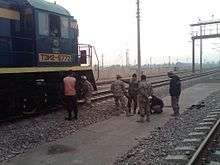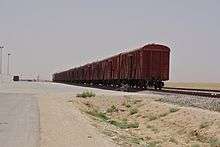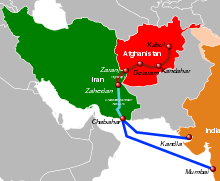Rail transport in Afghanistan
Afghanistan has three railroad lines in the north of the country. The first is between Mazar-i-Sharif and the border town of Hairatan in Balkh province, which then connects with Uzbek Railways of Uzbekistan (opened 2011). The second links Torghundi in Herat province with Turkmen Railways of Turkmenistan (opened 1960).[1] The third is between Aqina in Faryab province and neighboring Turkmenistan (opened 2016).[2] The country currently lacks a passenger rail service, but a new rail link from Herat to Khaf in Iran for both cargo and passengers is under construction and estimated for completion in 2018.[3] Passenger service is also proposed in Hairatan - Mazar-i-Sharif section and Mazar-i-Sharif - Aquina section.


Afghanistan's rail network is still in the developing stage. The current rail lines are to be extended in the near future, the plans include lines for cargo traffic as well as passenger transportation. Afghanistan's neighbors have been improving their own railway networks during the early 21st century. The main plan is to use Afghanistan to connect by rail the four subcontinents of Asia.
History
Kabul tramway
In the 1920s, King Amanullah bought three small steam locomotives from Henschel of Kassel in Germany, and these were put to work on a 7 kilometres (4.3 mi) long 2 ft 6 in (762 mm) gauge[4] roadside tramway linking Kabul and Darulaman. The December 1922 issue of The Locomotive magazine mentions "Travellers from Afghanistan state a railway is being laid down for a distance of some six miles from Kabul to the site of the new city of Darulaman, and also that some of the rolling stock for it is being manufactured in the Kabul workshops". The August 1928 issue of The Locomotive magazine mentions "the only railway at present in Afghanistan is five miles long, between Kabul and Darulaman". The tramway closed (date unknown), and was dismantled in the 1940s, but the locomotives still exist at Kabul museum in Darulaman.[4]
Proposed railways
Over the last century and a half, plenty of proposals have been made about building railways in Afghanistan. In 1885, the New York Times wrote about plans for connecting the Russian Transcaspian Railway, then under construction, with British India via Sarakhs, Herat, and Kandahar. When completed, the project would allow British officers to travel from London to India, mostly by rail, in 11 to 12 days (crossing the English Channel, the Black Sea, and the Caspian Sea by boat).[5]
About 1928, proposals were put forward for a railway to link Jalalabad with Kabul, eventually connecting to the (then) Indian system at Peshawar. Lines to join Kabul with Kandahar and Herat would follow later. Owing to political upheavals these plans were not implemented.
Industrial railways
In the 1950s a hydroelectric power station was built at Surobi, east of Kabul. Three Henschel four-wheel 600 mm (1 ft 11 5⁄8 in) narrow gauge diesel-hydraulic locomotives built in 1951 (works numbers 24892, 24993, 24994) were supplied to the power station.
In 1979 mining and construction locomotive builder Bedia Maschinenfabrik of Bonn supplied five D35/6 two axle diesel-hydraulic 600 mm (1 ft 11 5⁄8 in) narrow gauge locomotives, works numbers 150-154, to an unknown customer in Afghanistan.[6]
Track gauge
The choice of future track gauges in Afghanistan presents several difficulties. For strategic reasons, past Afghan governments preferred to discourage the construction of railways which could aid foreign interference in Afghanistan by Britain or Russia.[7] Afghanistan is surrounded by three different gauges, yet is almost completely without railways.[7]
Until the 21st century, there were fewer than 25 kilometres of railway inside the country, all of which is built to 1,520 mm (4 ft 11 27⁄32 in) Russian gauge. Afghanistan's neighbours to the north, namely the former Soviet republics of Turkmenistan, Uzbekistan, and Tajikistan, use this 1,520 mm (4 ft 11 27⁄32 in) gauge. Iran to the west uses standard gauge, 1,435 mm (4 ft 8 1⁄2 in) same as China, while Pakistan, which borders Afghanistan to the east and the south, uses 1,676 mm (5 ft 6 in) Indian gauge.
Railway stations
There are currently no passenger services or stations in Afghanistan. If any of the various cross-border links are completed and opened to passenger service, new stations will have to be built.
Proposed
Details of the preliminary list of stations to be served, which circle the central mountains of Afghanistan are available.[8]
National Rail Authority
The Afghan government is due to form a railway construction commission with technical cooperation provided by the European Commission, which was discussed at the G8 meeting in July 2011. The Commission will be responsible for supervising construction of a rail network within the country and its connection with the country's neighbors.[9] In October 2011, the Asian Development Bank approved funding for Afghanistan's national rail authority.[10] The Afghanistan Railway Authority has a website but, as of August 2017, there is very little on it. It does state that Afghanistan Railway Law (12 chapters and 105 clauses) was drafted in February 2013 and is awaiting approval from "relevant institutions".[11] Training has been provided by the United States Army's Afghanistan Railroad Advisory Team (ARAT).[12]
Current railways and future plans

Afghanistan–Uzbekistan rail service
In the early 1980s, the Soviet Union built an approximately 15 kilometers rail line from Termez in Uzbekistan to Kheyrabad in Afghanistan, crossing the Amu Darya river on the Afghanistan–Uzbekistan Friendship Bridge.[13] In January 2010, construction began on a 75-kilometer (47 mi) extension line between Afghanistan and Uzbekistan; this line is also 1,520 mm (4 ft 11 27⁄32 in) gauge as the first one built by the Soviets.[14] By December 2010, it began carrying construction materials for other reconstruction projects in Afghanistan.[15]
The line, which starts from Hairatan to Maulana Jalaluddin Balkhi International Airport in the northern Afghan city of Mazar-i-Sharif, was completed and is operated by Uzbekistan's national railway Uzbekiston Temir Yullari for a three-year-term until Afghanistan's own railways department takes over. The first freight services began running around August 2011.[16][17][18]
Uzbekistan has pledged in 2018 to part fund a major 657 km rail link from Mazar-i-Sharif west to Herat, which could create a route from Iran via Herat to Central Asia and potentially China.[19]
Afghanistan–Turkmenistan rail service
A 10-kilometer long line extends from Serhetabat in Turkmenistan to the town of Torghundi in Afghanistan.[1] An upgrade of this Soviet-built line dating back to the 1960s, using Russian gauge, began in 2007.[20] In April 2016, an agreement was reached for a technical feasibility study for a proposal to extend this line approximately 100 km to the city of Herat,[21] where it could connect to the standard-gauge line to Iran that is being built. In accordance with earlier decisions, the line is likely to be standard gauge, with break of gauge at Torghundi. In April 2018 it was decided by the Turkmen government to build a railway from Galkynysh Gas Field in the direction of Afghanistan, towards Torghundi.[22][23]
Another rail line was opened further east in November 2016, connecting Aqina in Faryab province via Imamnazar with Atamyrat/Kerki in Turkmenistan.[2] A planned 58 kilometres (36 mi) extension to Andkhoy is under proposal.[24] It is planned to become part of a rail corridor through northern Afghanistan, connecting it via Sheberghan to Mazar-i Sharif and on to the border with Tajikistan,[25] although it is unclear when this will happen.[26]
Afghanistan–Pakistan rail service
Two broad gauge 1,676 mm (5 ft 6 in) Pakistan Railways lines with steep gradients terminate on the border at Chaman and Torkham. In July 2010, Pakistan and Afghanistan signed a Memorandum of understanding for going ahead with the laying of rail tracks between the two countries. The rail tracks would link Quetta in Pakistan with Kandahar in Afghanistan and Peshawar in Pakistan with Jalalabad in Afghanistan.[27] The project soon fell off.
On May 29, 2012, the section from Chaman in Pakistan to Spin Boldak in Afghanistan (12 km) was approved,[28] though this never started.
On February 22, 2020 the first cargo train bound for Afghanistan left Karachi, Pakistan with a load of containers. Pakistan Railways Chairman Habib-ur-Rehman Gilani inaugurated the train on Saturday which departed from the Pakistan International Container Terminal in Karachi with 35 containers on board for the country’s southwest Chaman city bordering Afghanistan. From there, the goods will be shifted across the border via road, the Nation reported.[29]
Afghanistan–Tajikistan rail service
A multination rail link was planned between Afghanistan and Tajikistan in 2013.[30] The Uzbekistan section has been partly implemented in 2016.
In 2018 a 50 km extension from Kolkhozobod in Tajikistan to the Afghan border town of Sher Khan Bandar in Kunduz Province was approved with construction expected to start that year.[31]
North–south corridor
In September 2010, China Metallurgical Group Corporation (MCC) signed an agreement[32] with the Afghan Minister of Mines to investigate construction of a north-south railway across Afghanistan, running from Mazar-i-Sharif to Kabul and then to the eastern border town of Torkham. MCC was recently awarded a copper mining concession at Mes Aynak which would be linked to this railway. MCC is constructing a 921 km long 1,676 mm (5 ft 6 in) gauge railway line that will link Kabul with Uzbekistan in the north and Pakistan in the east.[33]
Afghanistan–Iran rail

The railhead in Iran closest to the Afghan border is at Khaf near Mashhad, and this is a 1,435 mm (4 ft 8 1⁄2 in) standard gauge freight line.[34] This line is currently being extended 202 kilometers east to Herat.[35][36] On April 17, 2007 Afghan Foreign Minister Rangin Dadfar Spanta said that work on the Khaf-Herat railway (freight only) project had already begun in 2006. In September 2012, it was reported that the Herat-Khawaf railway, 70 km of which is inside Afghanistan and 60 km inside Iran, was 90% complete.[37] In May 2015, it was announced that the line would be operationalised by April 2016. The date passed, and in February 2017, a completion date of March 2018 was announced.[38]
This rail route (Khaf-Herat) has four sections, two in Iran and two in Afghanistan. Within Iran, section 1, running from Khaf to Sangan (14 km), was completed in September 2016. Section 2, from Sangan to the Iran-Afghanistan border at Shamtiq (62 km), was completed in October 2017. That same month (October 2017), section 3, running within Afghanistan from the border at Shamtiq–Jono to the town of Ghurian (61.2 km) was completed. Section 4 is the line from Jono to Herat (63 km) which is being supported by Italy.[39][40] This seems to be still pending.
India and Afghanistan are working on extending this rail route from Herat to Mazar-i-Sharif.[41] Mazar-i-Sharif is already linked with Uzbekistan and Tajikistan via rail routes.[2][41] Herat also is already linked with Turkmenistan via rail and road routes.[2] India is also finalizing a plan to construct a 900-km railway line that will connect the port of Chabahar in Iran, being built with Indian help, to the mineral-rich Hajigak region of Afghanistan.[42][43] As far back as 2011, seven Indian companies had acquired rights to mine central Afghanistan’s Hajigak region, which contain Asia’s largest deposit of iron ore. The Government of India has pledged to spend $2bn in developing supporting infrastructure.[44]
In May 2016, during Indian Prime Minister Narendra Modi's trip to Iran, an agreement was signed to develop two berths at Chabahar port and to build a rail connection from Chabahar to the existing Iranian railway network. The link line would connect a point somewhere near the town of Bam to Chabahar port, as part of North–South Transport Corridor. Ircon International, a subsidiary of the state-owned Indian Railway, has been tasked with this project.[45] The establishment of the port of Chabahar's connection to the country’s railway plan, is under study and consideration. With completion of the Kerman–Bam-Zahedan railway and its future connection to the port of Chabahar, this port will connect to the Trans-Iranian Railway, and thus to both Afghanistan and Central Asia.
Breaks of Gauge
The initial phase of railway construction from 2010 sees the creation of five break-of-gauge stations.[8]
- Kandahar 1,676 mm (5 ft 6 in) / 1,435 mm (4 ft 8 1⁄2 in)
- Khyber Pass 1,676 mm (5 ft 6 in) / 1,435 mm (4 ft 8 1⁄2 in)
- Torghundi 1,520 mm (4 ft 11 27⁄32 in) / 1,435 mm (4 ft 8 1⁄2 in)
- Mazar-i-Sharif 1,520 mm (4 ft 11 27⁄32 in) / 1,435 mm (4 ft 8 1⁄2 in)
- Sher Khan Bandar 1,520 mm (4 ft 11 27⁄32 in) / 1,435 mm (4 ft 8 1⁄2 in)
In late 2016 updates, there are multiple breaks-of-gauge. These include: 1,520 mm (4 ft 11 27⁄32 in)/1,676 mm (5 ft 6 in) in the northern area, and 1,435 mm (4 ft 8 1⁄2 in)/1,520 mm (4 ft 11 27⁄32 in)/1,676 mm (5 ft 6 in) at Herat.
See also
- Transport in Afghanistan
- Khyber Pass Railway
- Eurasian Land Bridge
- North-South Transport Corridor
- Ashgabat agreement, a Multimodal transport agreement signed by India, Oman, Iran, Turkmenistan, Uzbekistan and Kazakhstan, for creating an international transport and transit corridor facilitating transportation of goods between Central Asia and the Persian Gulf.[46]
- Broad gauge
- Dual gauge
- Pakistan-Afghan-Central Asia railway project: The proposed 1,676 mm (5 ft 6 in) Indian gauge railways between Pakistan and the Central Asian Republics through Afghanistan.
- India-Xinjiang-Kazakh railway project: The proposed 1,676 mm (5 ft 6 in) Indian gauge railway between India and Kazakhstan through Xinjiang, China which will bypass Pakistan and Afghanistan.
- Pakistan-Xinjiang-Tajik railway project: The proposed 1,676 mm (5 ft 6 in) Indian gauge railway between Pakistan and Tajikistan through Xinjiang, China which will bypass Afghanistan.
- Pakistan-Iran-Turkmen railway project: The proposed 1,676 mm (5 ft 6 in) Indian gauge railway between Pakistan and Turkmenistan through Iran which will bypass Afghanistan.
References
- Kakar, Javed Hamim (December 2017). "Construction of Turkmen-Afghan railroad begins". Pajhwok Afghan News. Retrieved 1 December 2017.
- Salehai, Zarghona (28 November 2016). "Afghan-Turkmenistan railroad inaugurated". Pajhwok Afghan News. Retrieved 17 January 2017.
- https://financialtribune.com/articles/economy-domestic-economy/60378/rail-linkup-with-afghanistan-by-march-2018
- Kabul to Darulaman railway, Railways of Afghanistan
- "To India In Eleven Days.; Russia's Transcaspian Railway And The Time Necessary To Complete It", The New York Times, 1885-05-03
- https://web.archive.org/web/20070430101935/http://www.ajg41.clara.co.uk/afghanistan.html#sdfootnote40sym Railways in Afghanistan, past and future
- Railways in Afghanistan, past and future
- "Answering the Afghan rail question". Railway Gazette International: 63 (with map). October 2010.
- http://www.kuna.net.kw/NewsAgenciesPublicSite/ArticleDetails.aspx?id=2178307&Language=en
- Pajhwok Afghan News - ADB to give $222m for roads, rail tracks. Abdul Qadir Siddiqui. October 19, 2011.
- http://afra.gov.af/en/page/14258/afghanistan-railway-law
- Upton, Luke. "How the U.S. military is working to get an Afghanistan rail network on track". SmartRail World. Retrieved 29 August 2017.
- "Aid train reaches Afghanistan". Railway Gazette International. 2002-01-01. Archived from the original on 2012-05-27.
- Ben Farmer (13 June 2010). "Afghanistan to complete first railway by end of year". London: Daily Telegraph.
- "Railway Gazette: News in Brief". Retrieved 2011-01-02.
- "First major Afghan railway opens". Railway Gazette International. 25 August 2011. Retrieved 25 August 2011.
- "Afghan railway: First train runs on new line in north". BBC News. 2011-12-21.
- Afghan railway: First train runs on new line in north, BBC, 2011-12-11
- https://www.railwaygazette.com/news/infrastructure/single-view/view/uzbekistan-backs-afghan-rail-proposal.html
- "Afghan rebuild underway". Railway Gazette International. 2007-07-12.
- "Herat railway feasibility study contract signed". Railway Gazette. 18 April 2016.
- https://www.azernews.az/region/141734.html
- http://orient.tm/en/2018/04/12/6314.html
- Hejaab, Aslam (31 October 2016). "Work Begins On Aqina-Andkhoy Railway". ariananews.af. Retrieved 17 January 2017.
- Grantham, Andrew (31 October 2016). "TAT Railway". Railways of Afghanistan. Retrieved 19 January 2017.
- https://www.railwaygazette.com/news/news/asia/single-view/view/afghan-railway-terminal-expansion-mou-signed.html
- Kakar, Javed Hamim (2010-07-07). "Pakistan, Afghanistan ink MoU on rail links". Pajhwok Afghan News. Retrieved 2008-10-23.
- Railway Gazette International, July 2012, p30
- "Pakistan inaugurates Afghan transit cargo train service". Railpage. Retrieved 24 February 2020.
- "Afghanistan, Tajikistan, Turkmenistan Sign Railway MoU". The Gazette of Central Asia. Satrapia. 21 March 2013.
- https://www.railwaygazette.com/news/infrastructure/single-view/view/tajikistan-afghanistan-railway-construction-could-start-this-year.html
- "Agreement signed for north-south corridor". Railway Gazette International. 23 September 2010. Retrieved 2010-09-27.
- Construction on Kabul-Torkham Railway to Start Soon, Ministry of Mines Says Archived 2013-11-09 at the Wayback Machine. Tamim Shaheer, October 18, 2011.
- "Modern construction methods mastered on Mashhad - Bafgh line". Railway Gazette International. 2007-07-01. Archived from the original on 2012-05-27.
- "Rail Link With Herat". Iran Daily. 2007-02-27. Archived from the original on 2008-12-04.
- Murray Hughes (2008-01-29). "Opening up Afghan trade route to Iran". Railway Gazette International. Archived from the original on 2016-01-01.
- Herat-iran railway 90% complete
- 'Afghanistan, Iran rail link to be completed by March 2018', 1TV News, 26 February 2017
- Khaf Herat route to open within weeks, Mehrnews, 20 July 2017.
- Route of the Khaf – Herat railway, Andrew Grantham, 17 October 2017.
- "Politics of Trade Corridors.", Dispatch News Desk, 5 November 2017.
- http://www.hindustantimes.com/India-news/NewDelhi/India-s-Track-3-Afghan-Iran-rail-link/Article1-763448.aspx
- "Archived copy". Archived from the original on 2016-03-04. Retrieved 2012-01-06.CS1 maint: archived copy as title (link)
- "Afghanistan starts railway that will link it to the world.", [www.globalconstructionreview.com Global Construction Review], 20 September 2016.
- India-Iran sign key agreements, Published: 23 May 2016
- The Hans India - India accedes to Ashgabat agreement
Further reading
- Grantham, A. Railways in Afghanistan
- Waters, Paul E (2002). Afghanistan: A Railway History. Bromley: PWA. ISBN 0948904097.
- Afghanistan demain le rail pp. 6–14 + 27 pictures - vie du rail - n°1542 - 09/05/1976